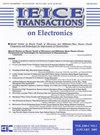Fine feature analysis of metal plate based on two-dimensional imaging under non-ideal scattering
IF 0.6
4区 工程技术
Q4 ENGINEERING, ELECTRICAL & ELECTRONIC
引用次数: 0
Abstract
SUMMARY The ideal point scattering model requires that each scattering center is isotropic, the position of the scattering center corresponding to the target remains unchanged, and the backscattering amplitude and phase of the target do not change with the incident frequency and incident azimuth. In fact, these conditions of the ideal point scattering model are difficult to meet, and the scattering models are not ideal in most cases. In order to understand the difference between non-ideal scattering center and ideal scattering center, this paper takes a metal plate as the research object, carries out two-dimensional imaging of the metal plate, compares the difference between the imaging position and the theoretical target position, and compares the shape of the scattering center obtained from two-dimensional imaging of the plate from different angles. From the experimental results, the offset between the scattering center position and the theoretical target position corresponding to the two-dimensional imaging of the plate under the non-ideal point scattering model is less than the range resolution and azimuth resolution. The deviation between the small angle two-dimensional imaging position and the theoretical target position using the ideal point scattering model is small, and the ideal point scattering model is still suitable for the two-dimensional imaging of the plate. In the imaging process, the ratio of range resolution and azimuth resolution affects the shape of the scattering center. The range resolution is equal to the azimuth resolution, the shape of the scattering center is circular; the range resolution is not equal to the azimuth resolution, and the shape of the scattering center is elliptic. In order to obtain more accurate two-dimensional image, the appropriate range resolution and azimuth resolution can be considered when using the ideal point scattering model for two-dimensional imaging. The two-dimensional imaging results of the plate at different azimuth and angle can be used as a reference for the study of non-ideal point scattering model.基于非理想散射二维成像的金属板精细特征分析
理想的点散射模型要求每个散射中心是各向同性的,散射中心对应目标的位置保持不变,目标的后向散射振幅和相位不随入射频率和入射方位角的变化而变化。实际上,理想点散射模型的这些条件很难满足,散射模型在大多数情况下都是不理想的。为了了解非理想散射中心与理想散射中心的区别,本文以金属板为研究对象,对金属板进行二维成像,比较成像位置与理论目标位置的差异,并比较从不同角度对金属板进行二维成像得到的散射中心形状。从实验结果来看,非理想点散射模型下平板二维成像所对应的散射中心位置与理论目标位置之间的偏移量小于距离分辨率和方位角分辨率。理想点散射模型的小角度二维成像位置与理论目标位置的偏差较小,理想点散射模型仍然适用于平板的二维成像。在成像过程中,距离分辨率和方位角分辨率的比值影响着散射中心的形状。距离分辨率等于方位角分辨率,散射中心形状为圆形;距离分辨率不等于方位角分辨率,散射中心呈椭圆形。为了获得更精确的二维图像,在使用理想的点散射模型进行二维成像时,可以考虑适当的距离分辨率和方位角分辨率。平板在不同方位角下的二维成像结果可为非理想点散射模型的研究提供参考。
本文章由计算机程序翻译,如有差异,请以英文原文为准。
求助全文
约1分钟内获得全文
求助全文
来源期刊

IEICE Transactions on Electronics
工程技术-工程:电子与电气
CiteScore
1.00
自引率
20.00%
发文量
79
审稿时长
3-6 weeks
期刊介绍:
Currently, the IEICE has ten sections nationwide. Each section operates under the leadership of a section chief, four section secretaries and about 20 section councilors. Sections host lecture meetings, seminars and industrial tours, and carry out other activities.
Topics:
Integrated Circuits, Semiconductor Materials and Devices, Quantum Electronics, Opto-Electronics, Superconductive Electronics, Electronic Displays, Microwave and Millimeter Wave Technologies, Vacuum and Beam Technologies, Recording and Memory Technologies, Electromagnetic Theory.
 求助内容:
求助内容: 应助结果提醒方式:
应助结果提醒方式:


